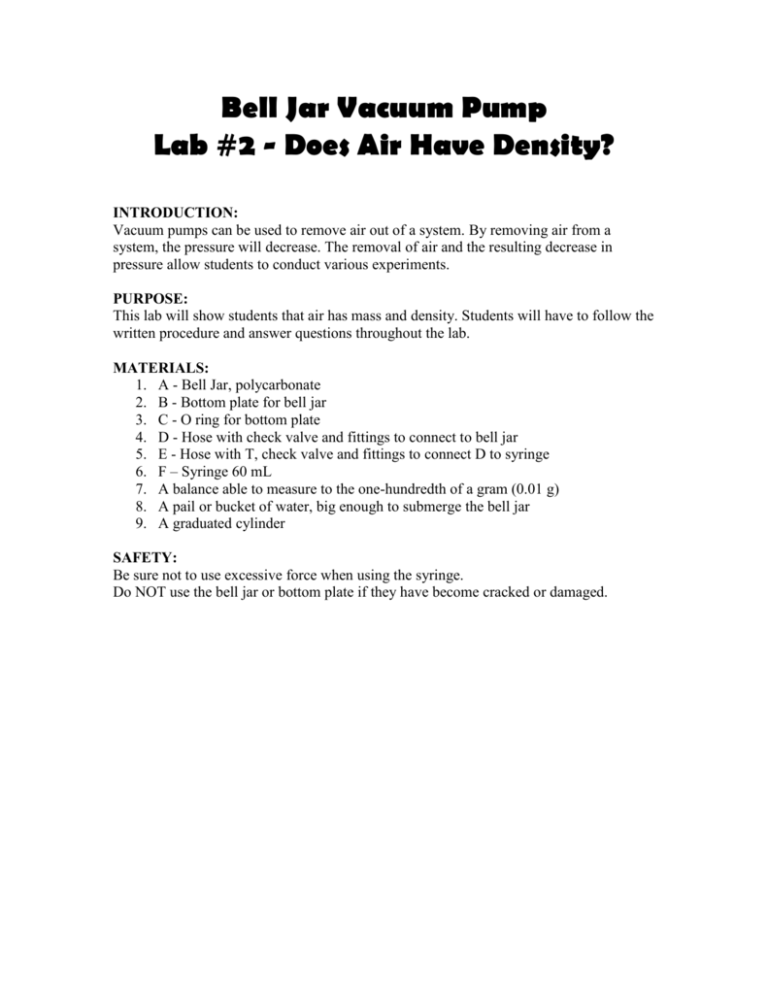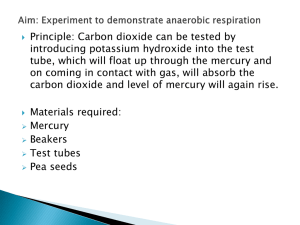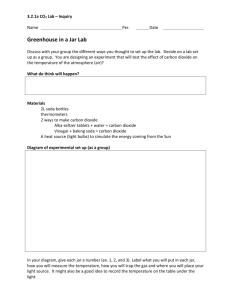MIXTURES AND COMPOUNDS SIMULATION LAB
advertisement

Bell Jar Vacuum Pump Lab #2 - Does Air Have Density? INTRODUCTION: Vacuum pumps can be used to remove air out of a system. By removing air from a system, the pressure will decrease. The removal of air and the resulting decrease in pressure allow students to conduct various experiments. PURPOSE: This lab will show students that air has mass and density. Students will have to follow the written procedure and answer questions throughout the lab. MATERIALS: 1. A - Bell Jar, polycarbonate 2. B - Bottom plate for bell jar 3. C - O ring for bottom plate 4. D - Hose with check valve and fittings to connect to bell jar 5. E - Hose with T, check valve and fittings to connect D to syringe 6. F – Syringe 60 mL 7. A balance able to measure to the one-hundredth of a gram (0.01 g) 8. A pail or bucket of water, big enough to submerge the bell jar 9. A graduated cylinder SAFETY: Be sure not to use excessive force when using the syringe. Do NOT use the bell jar or bottom plate if they have become cracked or damaged. SETUP: The diagram below shows how the bell jar vacuum should be setup. Figure 1 – Bell jar vacuum pump setup. 1. The O ring, part (C), should already be installed on the bottom plate, part (B). If the O ring is not around the bottom plate, carefully put it on the bottom plate by gently stretching it into position. 2. The bell jar, part (A), fits over the smaller diameter portion of the bottom plate with the rim in contact with the O ring. 3. One fitting of part (D) will connect with the top of the bell jar, part (A). Only a slight turn, approximately one-third of a gentle turn, is all that is needed to make a secure connection. DO NOT OVER TIGHTEN!! 4. The fitting from the side are of the T of part (E) connects to the syringe, part (F), with a slight turn. DO NOT OVER TIGHTEN!! One of the other fittings of part (E) will connect to the remaining unconnected fitting of part (D). Only a gentle partial turn will be needed. DO NOT OVER TIGHTEN!! The remaining connector of part (E) will be left unconnected. PROCEDURE: Part One – This part may be skipped if the students have already done Lab #1 – The Phantom Mass. 1) Assemble the apparatus as shown in figure 1. Pull the piston out of the syringe out to the 60mL mark and then push it back in all the way. Repeat this 30 times. 2) Disconnect part D from E. Place the bell jar, hose D, bottom plate, and O ring on a balance. Make sure hose D is not touching anything. Record the mass. _______________________ 3) Loosen the connection between hose D and the bell jar, remove the hose and then reconnect it. Did you hear the movement of air? What was the air doing? _________________________________________________________________ 4) Place the bell jar, hose D, bottom plate and O ring on the balance. Make sure hose D is not touching anything. Record the mass. _______________________ 5) Calculate the difference between the balance readings in steps 2 and 4. ________ What is this answer the mass of? _____________________________ 6) Do you think the bell jar was really empty when you weighed it in step 2? Why? _________________________________________________________________ Part Two: 1) Assemble the apparatus as in figure 1. Pump the piston 30 times. 2) Disconnect hose D from hose E. Hold the bottom plate onto the bell jar. Holding the bell jar upside-down, completely submerge the apparatus in the water. With the hose fitting down, loosen and then remove the hose. Describe what happens and explain why it happens. __________________________________________________________________ __________________________________________________________________ __________________________________________________________________ 3) Put your finger over the hose fitting on the bell jar and lift it out of the water. Keep your finger over the hose fitting. There will be some air in the bell jar. What does this prove? _________________________________________________________________ 4) Estimate what fraction, or percentage, of the air was left? ___________________________ 5) What percentage of the air was removed? ___________________________ 6) Use a graduated cylinder to measure the volume of water in the bell jar. Record this volume and determine what this represent. ________________________________________________________________ 7) Now you know the mass (either from Lab #1 or Part One in this lab) and the volume of the air that you removed. Calculate the density of air. Show your calculations. Remember to include units of measurement in your answer. 8) Dry out the apparatus as well as you can with a towel. DOES AIR HAVE DENSITY? TEACHER NOTES LAB TIME: This lab will probably take 2 to 3 (50 minute) periods including discussion depending on how much discussion will take place. PREPARATIONS: TIME: This lab will take very little prep time, perhaps 1 prep period. ANSWERS TO QUESTIONS: Part One: 2. 3. 4. 5. ~103 g. Yes, a noise could be heard. It was from the air rushing into the bell jar. The mass should increase by about 0.2 g. The difference should be about 0.2 g. This is the mass of the air removed from the bell jar. 9. Answers will vary as the students have no basis for answering this question from this experiment. Part Two: 2. Water filled almost all of the bell jar. The bell jar was filled with water because it was submerged in water. 3. This proves that not all of the air was removed from the bell jar. 4. About 5% or 1/20 of the air remained in the bell jar. 5. About 95% or 19/20 of the air was removed from the bell jar. 6. About 210 mL of water was in the bell jar. This represents the volume of air removed from the bell jar. 7. Mass = ~0.2 g Volume = ~210 mL Density = mass/volume = 0.2 g / 210 mL = 0.000952 g/mL Source: Housley, J.M., Bell Jar & Vacuum Pump Set. Transparent Devices, 1999.






